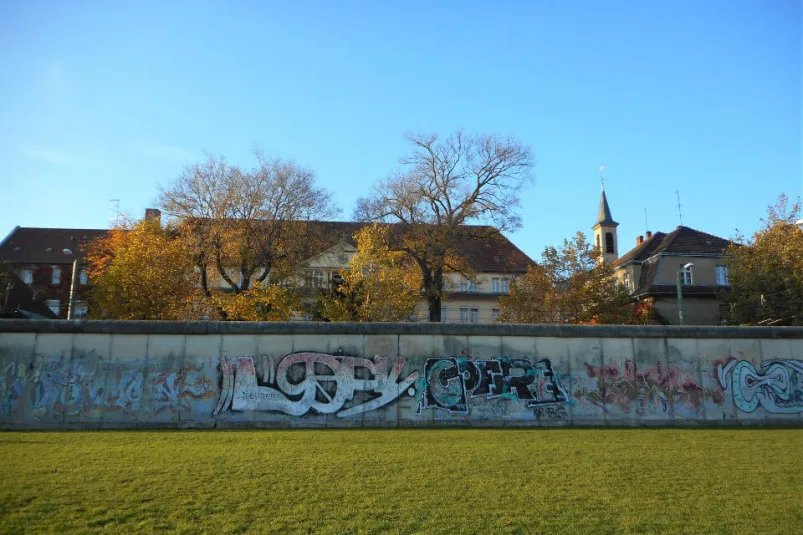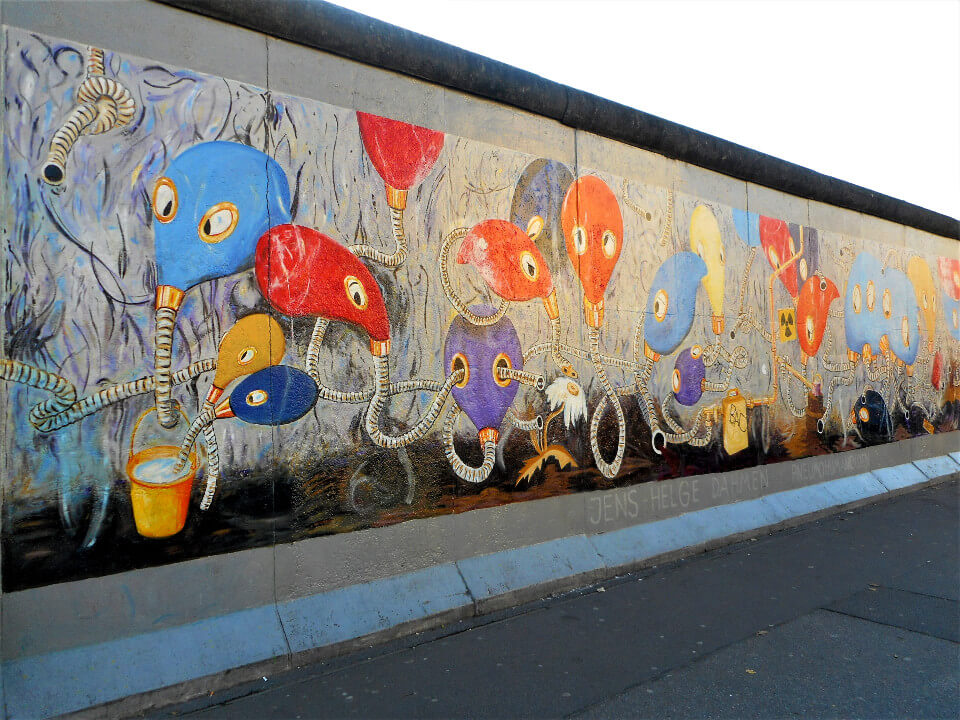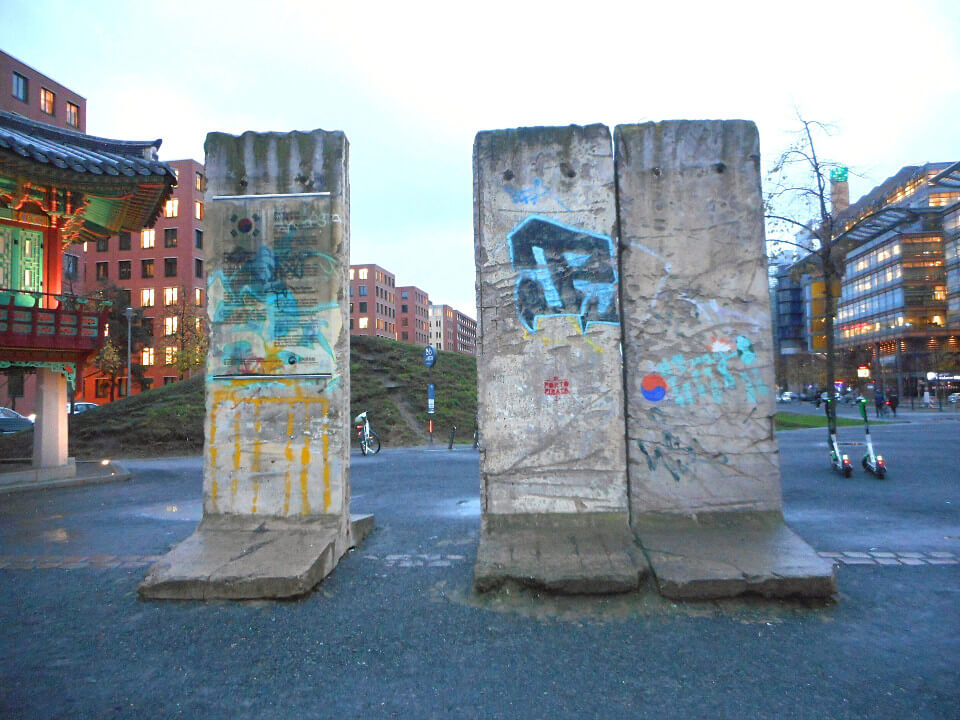15 Places to see the Berlin Wall Remains today

It is impossible to separate Berlin from its Wall. A symbol of the Cold War, it continues to leave its mark on people's minds with its presence on both sides of the city.
In the aftermath of the Second World War, Berlin and Germany were divided into four sectors of occupation divided between the Soviet, American, French and British allies. The Soviets manage the eastern side, while the West shares the western side. In the following years, many East Germans took advantage of the free movement between the two areas to flee to the West. In order to stop this massive migration and retain their workforce, communist leaders suddenly closed their borders. On the morning of August 13, 1961, the Berliners woke up in a city physically separated in two.
If at first they were simple barbed wire and soldiers positioned on the demarcation lines, a complex military system was quickly put in place. It consists of several walls, one background and one exterior, between which there was a pathway, a no-man's-land, lighting pylons and a signal fence. The "Berlin Wall" was born and will divide the city for more than twenty-eight years.f
On 9 November 1989, an officer stated on television that the visa procedures for the Ossis (East Germans) had been relaxed. The latter flock en masse to border crossings and force their opening. For the first time in nearly three decades, East and West are once again free to mix. The Berliners, finally reunited, hastened to demolish the "Wall of Shame".
However, some remains of the Berlin Wall remain throughout the German capital. We suggest you discover a number of them, divided by sector, in order to facilitate their visit.
1. East Side Gallery: the longest piece of wall still visible (Friedrichshain)

Berlin Wall, East Side Gallery in Berlin
Near the Oberbaumbrücke, the East Side Gallery is the remains of the most famous Wall. At 1,316 metres, it is also the longest section of wall in Berlin. When it is divided, the Spree, the river that flows through Berlin, serves as no man's land. The border system is lighter in this area and only this portion of the background wall remains.
In 1990, artists from 21 countries were invited to paint the concrete surface of their works. Some of them have become emblematic. This is the case of the "fraternal kiss" between the Soviet leaders Brezhnev and Honecker by the Russian artist Dimitri Vrubel. Or "Test the Best" and its Trabant, an iconic car from the East, which pierces the Wall. The gallery was completely renovated in 2009. (see the 10 most famous murals of the East Side Gallery in Berlin)
Address: Mühlenstraße 3-100, 10243 Berlin
2. The former command post in Schlesischer Busch (Alt-Treptow)

The former command post in Schlesischer Busch (Alt-Treptow)
15 minutes walk from the East Side Gallery and the Oberbaumbrücke, this former command post is visible from the Puschkinallee. From a height of 10 metres, it commanded 18 surrounding watchtowers and their electrical devices. It was completely restored in 2004.
Address: Puschkinallee 55, 12435 Berlin
3. Remains of the Wall in the Bornholmer Straße, former border crossing (Prenzlauer Berg)
For 28 years, Bornholmer Straße was home to one of the 12 border crossings that allowed people to cross between the German Democratic Republic (GDR) and the Federal Republic of Germany (FRG). On 9 November 1989, a GDR officer stated on television that East Germans could now travel to the FRG. A large number of Chassis then gathered at Bornholmer Straße and demanded to move west. With the authorities overwhelmed by the sudden situation and the influx of crowds, the crossing point opened shortly after 11 p.m. He was the first before being followed by other posts throughout the city.
Today, along the Bornholmer Straße, from Björnsonstraße to Bösebrücke, an almost intact portion of the background wall is visible. On the ground, indications retrace hour by hour the unfolding of the events of this historic day. A permanent exhibition is also available in the commemorative square of November 9, 1989.
Address: Platz des 9. November 1989 / Bornholmer Str. 70, 13359 Berlin
4. Remnants of the Wall in the Norwegerstraße and Behmstraße
On the Platz des 9. November 1989, go down the stairs leading to Norweger Straße and turn left. Entire sections of a 1900 wall that delineates the adjacent railway line can be followed. This wall was used in the border system and is, as such, a relic of it.
5. Bernauer Straße - The Berlin Wall Memorial

Wall remains in the Bernauer Straße
When Berlin was divided, the Bernauer Straße (Bernauer Street) suffered the same fate. Its sidewalks on the south side belong to the East, those on the north side to the West. The Chassis used the dwellings in the East to escape the GDR and did not hesitate to jump out of windows to reach the FRG. These buildings are then walled up, on the ground floor, then on the upper floors, then finally razed to the ground. At their location is currently the Berlin Wall Memorial. This is the only place where the entire military border system, as developed in the 1980s, can still be seen.

Memorial of the Berlin Wall (Gedenkstätter Berliner Mauer)
The memorial includes entire sections of the Wall as well as an installation of steel plaques and posts representing the former "Iron Curtain". The Berlin Wall Documentation Centre, an observation platform and the "Chapel of Reconciliation", a tribute to the church destroyed in 1985 by the East German regime, can also be visited free of charge.
Visitor Center: Bernauer Straße 119, 13355 Berlin
Documentation Centre: Bernauer Straße 111, 13355 Berlin
Opening hours: From Tuesday to Sunday, from 10am to 6pm.
6. Der Mauerpark und die legale Graffiti-Wand (Prenzlauer Berg)
The residents of the district militated for the transformation the no-man's-land of the border system into a green space after the fall of the Wall. It was transformed into a park and opened to the public in 1994. The new Mauerpark (Wall Park) will soon become a popular destination for Berliners and tourists who come to enjoy its relaxed atmosphere.
Today, visitors flock on Sundays to enjoy its lawns and sports fields as well as its flea market, not to mention its must-see karaoke. The public space retains within it a remnant of the Berlin Wall. A background portion of approximately 300 metres now serves as a legal graffiti wall and is a delight for graffiti artists and street art lovers.
Address: Bernauer Str. 63-64, 13355 Berlin
7. Park am Nordbahnhof

Remains of the Berlin Wall in Park am Nordbahnhof
This park, located opposite the Nordbahnhof (Northern Station), was built on the foundations of a former station. When the city was separated, the land was part of the border facilities between East and West Berlin. Very soon after the fall of the Wall, the vegetation regained its rights and it was decided to preserve it by creating a public garden. The wall that delimits the green space of the railway track consists largely of the remains of the Wall.
8. Remnants of the Wall in the Liesenstraße

Remnants of the Wall in the Liesenstraße
A small portion of the wall is visible at the intersection of Liesenstraße and Gartenstraße, near Liesenbrücken, the bridge over which the S-Bahn drives.
9. St. Hedwig's cemetery (St. Hedwig-Friedhof)
In the continuity of Liesenstraße, St. Hedwig's cemetery houses a section of the wall. This is located on the first road on the right after the main entrance.
10. Invaliden Cemetery (Invalidenfriedhof)

Berlin Wall in the Invaliden cemetery (Invalidenfriedhof)
This cemetery, built in 1748, is one of the oldest in Berlin. On the banks of the Spandau Canal, it was for a long time the last resting place of illustrious Prussian soldiers before welcoming civilians.
When Berlin was divided by the Allies, the border route passed through the middle of the site. And when East Germany reinforced its borders in 1961, the cemetery was partially demolished. The border arrangement was erected between the remaining graves before they were all buried.
In 1990, it was decided to restore the cemetery to its original function with the reconstruction of some tombs while preserving part of the 180-metre long Wall, which can still be seen today.
Address: Scharnhorststraße 31, 10115 Berlin
11. Kieler-Eck - Günter-Liftin Memorial
A stone's throw from the Invaliden Friedhof, on Kieler Straße, one of the 302 watchtowers that stood along the East-West border has been preserved as it stands. The former command post, now surrounded by buildings, is also a memorial to Günter Liftin, one of the first victims of the Wall.
An East German who worked in the West, the strengthening of borders puts an end to his career plans. The 24-year-old then decided to swim west into the nearby canal. Unfortunately, guards spotted him from this viewpoint and, after a few warning shots, eventually shot him down.
The memorial and the preservation of the building were decided on his brother's initiative after the fall of the wall.
The memorial is open to the public from May to September, Saturdays and Sundays from 10am to 4pm. Guided tours are offered regularly.
Address: Kieler Straße. 2, 10115 Berlin
12. Rests of the Wall on Potsdamer Platz and Leipziger Platz

Rests of the Berlin Wall on Potsdamer Platz
Before the war, Leipziger Platz and its neighbour Potsdamer Platz were prestigious epicentres of Berlin life. Heavily damaged by the bombardments and fighting in the capital, they were nothing more than fields of ruins at the end of the conflict. After the separation of the city, the places split in two became a vast no man's land, immortalized by the film Wings of Desire by Wim Wenders.
After a major reconstruction project, Potsdamer Platz and Leipziger Platz now welcome hundreds of thousands of visitors per year. These are crowded into the huge shopping malls, attractions and surrounding cinemas. They can also search for the portions of the Wall that have been distributed on either side. In particular a piece near the traditional Korean pavilion on Potsdamer Platz.
13. Watchtower in the Erna-Berger-Straße

Wachturm in the Erna-Berger-Straße
Between Potsdamer Platz and Niederkirchnerstraße, an octagonal viewpoint from 1961 still stands in Erna-Berger-Straße. It is part of the first generation of the border system, which has been continuously improved during its existence.
A section of wall can also be seen from the illuminated windows of the Bundesministerium für Umwelt, Naturschutz und nukleare Sicherheit (Federal Ministry of the Environment) which forms the corner of Erna-Berger-Straße and Stresemannstraße.
14. Topography of Terror in the Niederkirchnerstraße (Mitte)

Wall remains, Topography of Terror, Niederkirchnerstraße
Under the National Socialist regime, the Nazis established the headquarters of the Gestapo and the SS as well as the Ministry of Internal Security on Niederkirchnerstraße. The first two were bombed and then destroyed after the war. At the time of the Berlin division, the Eastern military system was installed in this street which led to the famous Checkpoint Charlie border crossing.
After heated discussions during the reunification of the city, it was finally decided to preserve a section of about 200 metres of the Wall. It now borders the "Topography of Terrors" museum built on the foundations of the Gestapo headquarters. Partially stripped and damaged by the "pics-mursurs", collectors in search of pieces of buildings, it was left as it was.
15. Rüdower Höhe
A park built in the 1950s that offers a toboggan run and other observation terrace, Rüdower Höhe (Rüdow Height) is a delight for nature lovers, on foot or by bike. Located at the southern end of the Neukölln district, this park also houses an entire 354-metre long remnant of the Wall. Protected by a fence, one can still see the original white paint used to identify possible escapee silhouettes. As for graffiti, they date back to years after the fall of the Wall, this part of the Wall having only been classified in 2001.
16. S-Bahn Schönholz / Reinickendorf
On the borders of the districts of Pankow and Reinickendorf, this former portion was updated in 2018 by Christian Bormann, a former East Berliner. Located in a wood near Pankow III Cemetery and Volkspark Schönholzer Heide, it has been forgotten for nearly three decades. Since then, it has been officially recognized as a remnant of the Wall and a classified monument. A fence has been installed within its perimeter to prevent looting of the "picmurs murs". This piece of wall can still be seen through the fence and its surroundings as well as from the adjacent S-Bahn station.
From the S-Bahn station exit, go north on Provinzstraße, turn right onto the small dirt road and continue on the rightmost path along the railway track.
Map of the Berlin Wall remains
After several decades, the Berlin Wall continues to leave its mark on the city it has separated for so long. Its scattered relics remind us that, in the still recent past, travel was limited and that the freedom that so much characterizes it was far from reigning there.
To explore this subject in more detail, the Mauermuseum - Museum Haus am Checkpoint Charlie (Wall Museum) and the Berlin Wall Memorial and Documentation Centre welcome visitors all year round.
The daily Berliner Morgenpost has also launched an interactive website that allows you to compare photographs of the capital with and without the Wall. An enlightening insight into a situation that is unthinkable today and yet existed!

Mélodie Julienne
Writer
As a web writer, I am passionate about cinema and literature. As soon as I arrived in Berlin, I was charmed. Between two trips, I like to walk its streets and let myself be carried away by its singularity, full of creativity. An infinite fascination that I love to share!